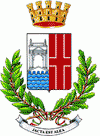Rimini (Provincia di Rimini)
 |
The city was founded by the Romans in 268 BC. Throughout Roman times, Rimini was a key communications link between the north and south of the peninsula. On its soil, Roman emperors erected monuments such as the Arch of Augustus and the Tiberius Bridge to mark the beginning and the end of the Decumanus of Rimini. During the Renaissance, the city benefited from the court of the House of Malatesta, which hosted artists like Leonardo da Vinci and produced works such as the Tempio Malatestiano. The main monuments in Rimini are the Tiberius Bridge and the Arch of Augustus.
In the 19th century, Rimini was one of the most active cities on the revolutionary front, hosting many of the movements seeking to achieve Italian unification. In the course of World War II, the city was the scene of numerous clashes and bombings, but also of a fierce partisan resistance that earned it the honour of a gold medal for civic valour. In recent years it has become one of the most important sites for trade fairs and conferences in Italy.
As of 31 December 2019, Rimini's urban area was home to 151,200 people, with approximately 325,000 living in the eponymous province, making it the twenty-eighth largest city in Italy. The city is located near the independent republic of San Marino and the Misano race track.
Map - Rimini (Provincia di Rimini)
Map
Country - Italy
 |
 |
| Flag of Italy | |
Italy was the native place of many civilizations such as the Italic peoples and the Etruscans, while due to its central geographic location in Southern Europe and the Mediterranean, the country has also historically been home to myriad peoples and cultures, who immigrated to the peninsula throughout history. The Latins, native of central Italy, formed the Roman Kingdom in the 8th century BC, which eventually became a republic with a government of the Senate and the People. The Roman Republic initially conquered and assimilated its neighbours on the Italian peninsula, eventually expanding and conquering a large part of Europe, North Africa and Western Asia. By the first century BC, the Roman Empire emerged as the dominant power in the Mediterranean Basin and became a leading cultural, political and religious centre, inaugurating the Pax Romana, a period of more than 200 years during which Italy's law, technology, economy, art, and literature developed.
Currency / Language
| ISO | Currency | Symbol | Significant figures |
|---|---|---|---|
| EUR | Euro | € | 2 |
| ISO | Language |
|---|---|
| CA | Catalan language |
| CO | Corsican language |
| FR | French language |
| DE | German language |
| IT | Italian language |
| SC | Sardinian language |
| SL | Slovene language |


























